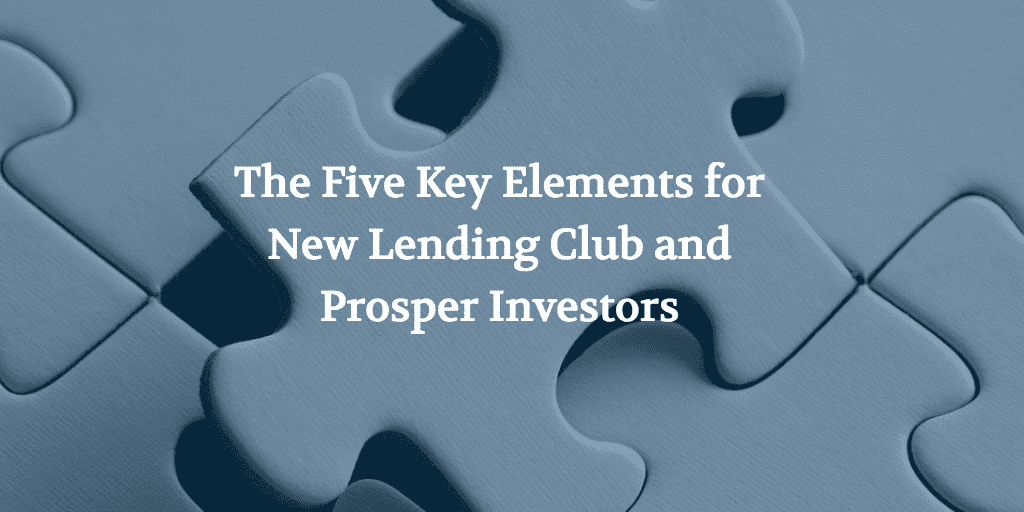 April is officially Financial Literacy Month here in the United States so with that in mind I am providing this resource for new investors in Lending Club and Prosper. While many of these principals apply to investing in marketplace lending more broadly I am focusing on these two companies since they are still the two best options for non-accredited investors. Below are what I consider to be the most important success factors for new investors.
April is officially Financial Literacy Month here in the United States so with that in mind I am providing this resource for new investors in Lending Club and Prosper. While many of these principals apply to investing in marketplace lending more broadly I am focusing on these two companies since they are still the two best options for non-accredited investors. Below are what I consider to be the most important success factors for new investors.
- Diversify Your Investment
When you decide to take the plunge and open an account at Lending Club or Prosper the temptation can be to put your money to work quickly. But far more important than that is to diversify properly. The minimum investment is $25 per loan so if you invest $5,000 then you can and should invest in 200 different loans. This way, if any loan defaults right away you can only lose 0.5% of your investment. My rule of thumb is that I don’t increase the note size above $25 per note until my balance is more than $10,000. To learn more you can read the dedicated pages on diversification at both Lending Club and Prosper.
- Expect Defaults
A friend of mine emailed me the other day asking me what was wrong with his account. He started off with Lending Club last year and was earning more than 12% investing in a selection of A, B and C-grade loans. Now, his account has passed the year mark and he is down below 8%. The fact is that nothing is “wrong” with his account. He has just had a bunch of defaults and while that it is always disappointing it is also completely normal. Even if you invest in only A-grade loans you will almost certainly experience defaults at some point. Every time you place an order both Lending Club and Prosper provide you with an estimated default rate and an expected return. You should take more notice of these numbers than the yield on the individual loan. Lending Club also has a great resource tool that shows how you compare to other investors with a similar risk profile. This can be useful for knowing that others are having a similar experience to you when it comes to defaults.
- Keep Your Cash Balance Low
One of the great things about an investment in Lending Club or Prosper is that you start getting money back within 30-45 days of making your first investment. You are investing in fully amortizing loans, so what this means is that every month you are receiving interest and principal payments. So your cash can build up pretty fast. For some of my large accounts I receive dozens of payments every single day. This cash will remain in your account earning 0% interest so I like to try to reinvest this money as quickly as possible. Which brings me to my next point.
- Automate Your Investing
When I first started investing in Lending Club and Prosper I liked to login every day to check on my investments and to put my idle cash to work. But eventually I tired of that so I setup automated investing. Both Lending Club and Prosper offer their own automated tools that allow you to choose a preset mix of loans or invest using your own strategies. There are also third party tools from NSR Invest (full disclosure: NSR Invest is a sister company to Lend Academy) and LendingRobot that also allow automated investing and these tools have far more flexibility than the platforms’ home grown tools. Both these companies also provide fully managed solutions where you can use their professional credit models to invest. Regardless of which option you choose the beauty of automated investing is that it can easily keep your cash balance low without having to login regularly.
- Avoid Taxes by Investing Through an IRA
The biggest negative about investing in Lending Club and Prosper is the tax treatment of these investments. You have to pay ordinary income on all the interest earned but you only get to deduct a maximum of $3,000 on the losses sustained from defaults (read our tax guide for more detailed information). Today, I only invest new money in IRA accounts simply because of these tax reasons. Both Lending Club and Prosper allow you to open an IRA account and will pay the account fees (it is $100) for you if you invest a minimum of $5,000 (you need to increase this to $10,000 in the second year to maintain the free account). You can also roll over an existing 401(k) or IRA account.
I realize that many Lend Academy readers are experienced investors so I would be happy to hear from you. What advice would you give to new investors that I have not covered here?

